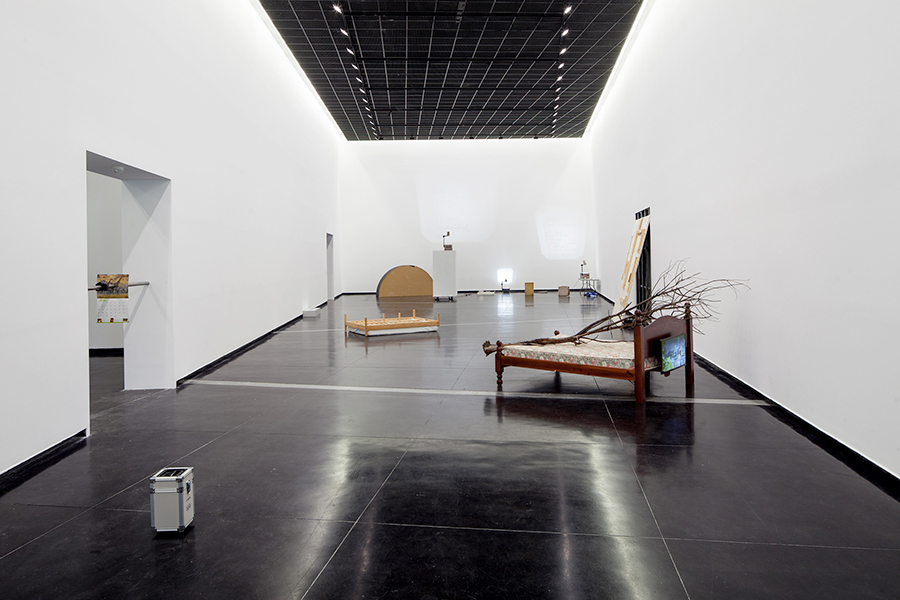Shows
“NEW 15”


In various transits across the world, pockets are chiming with tiny objects. Everyday items such as can-tabs and stones, recreated as silver, bronze and ceramic “pocket sculptures,” are hitching a ride with the people who possess them. These diminutive miscellanies, made by artist Kate Newby, are part of the Australian Centre for Contemporary Art’s (ACCA) “NEW 15” exhibition—though the objects are yet to see the inside of the gallery. Instead they have been gifted to the exhibition’s eight artists and curator for the duration of the show, travelling where they each person travels, seeking intimate meetings and finding new sites for display.
This sort of unexpected turn predicates ACCA’s annual showcase of emerging talent, who have been handpicked to exhibit their most vanguard work at the iconic Melbourne institution. In the past, guest architects and curators have altered the gallery considerably, establishing challenging parameters for their chosen talent to respond. This year, artist and “NEW” exhibition alumni Matt Hinkley chose eight artists from Australia and, for the first time, New Zealand, to occupy, alter and alienate ACCA’s bounds. Unlike more ostentatious incarnations from previous years, Hinkley asked that the space be returned to its original state—for him, the archetypal site was enough.
This modesty defines both Hinkley’s art practice and overall decision making. He didn’t choose artists based on a desire to show particular existing works, nor was he overt with his curatorial direction. Instead, he chose those whose practices have captivated him over an extended period of time—artists who would be able to rise to the occasion and challenge the exhibition space, viewers and their own oeuvre. In turn, Hinkley’s selected artists have delivered works that are diverse and fresh, with some having been conceived even as the show was being installed.

Though the exhibition revolves around the concept of newness, the works seem to invigorate the past through an exploration of the “second-hand” or the “re-take.” In Adelle Mills’ videos, words and actions are re-enacted from memory or an obscured set of instructions, amplifying the lacuna present in even our most intimate communications. Paul Bai’s “borrowed” installation—which includes a large neon sculpture by Janet Burchill and Jennifer McCamley (Inland Empire, 2008)—is an allusion to a Lynchian other-world. A blue-screen-like wall and a live feed of the gallery’s doorway (filmed by a surveillance camera installed on the ceiling), where visitors are reflected back through a luminescent orb, is an inflected portal—a site in constant mediation with its audience. Alex Vivian’s sprawling objects in various states of decay—mouldy microwaveable pasta, damaged plinths, hell-gone cream cheese—reflect his poetic definition of neglect as an energetic state and one that continues to evolve instead of destruct.
Elsewhere, in keeping with this thematic focus on the past, there are odes to historical places and people and the things they have produced. In George Egerton-Warburton’s Eucalyptus Standard (2015), a dead gum tree is laid to rest, quite literally, on a mattress. The tree, taken from American conceptualist Agnes Denes’s site-specific environmental installation in Melbourne’s outer suburbs (A Forest For Australia, 1998), pays homage to her aforementioned work, which now stands neglected and forgotten. In contrast, Richard Frater’s central and formidable April (2015) comprises a Greenpeace calendar and a camera both skewered onto a steel pole, which horizontally bisects an entryway located within the gallery space. The camera—its line of sight now replaced with the artist’s violent intervention—makes reference to the French intelligence service’s fatal bombing of Greenpeace’s Rainbow Warrior ship, while the latter was en route to protest the country’s nuclear test in the Pacific atoll of Moruroa in 1985. In a caustic turn of events, one of the offending French officials, Alain Mafart-Renodier, who became a nature photographer in later life, was unwittingly commissioned to photograph the calendar image that is seen pierced in Frater’s installation.
In a subtle ode to sites of reflection, Ash Kilmartin has created a poetic intervention with En Ondes (2015), where a section of ACCA’s wall is cut out and spun around, revealing the remnants and scars of past exhibitions. Tucked behind the inverted wall are two additional items—an old boom-box that whispers Kilmartin’s personal reflections of an abandoned observatory in Parramatta, New South Wales, and an excavation of gallery paint that reveals a miniature palimpsest of walls from the past. Here, two loci for understanding the world—the observatory and the gallery—are united.
As with any recollection of history, there is also an evocation of absence. Like Kate Newby’s travelling sculptures that have never seen the literal space of the exhibition, there is another work on display that is similarly evasive. Jessie Bullivant directed the gallery’s invigilators to offer a casual bodily shrug to passersby. While viewing the show, an eccentric visitor insisted upon seeing “the shrug”: not the performative action, but an actual garment that the person believed was hidden somewhere in the space. Bullivant’s work leads the audience to search for the inconspicuous that at times goes unnoticed, which nonetheless infiltrates the institutional cocoon, however subtly.
Overall, the atmosphere of the exhibition is quiet and subdued, interrupted only by the nuanced inflections of the eight artists’ works. Together they create a secondary thread, informed by a penchant for reinvigoration, which permeates the show. Here, each artist has introduced an old or alternative site, action or artwork into ACCA’s blank shell. This is not to deny the gallery’s own history, as seen in Kilmartin’s wall strata. Yet Hinkley’s modest curation allows the works of the exhibition, both shown in and outside the gallery, not to fall beneath the potential theatrics of the space’s architecture, but to become elevated through the show’s incitation toward rebirth and newness.

“NEW15” is on view at the Australian Centre for Contemporary Art, Melbourne, until May 17, 2015.
Laura Skerlj is a Melbourne-based artist and writer.







